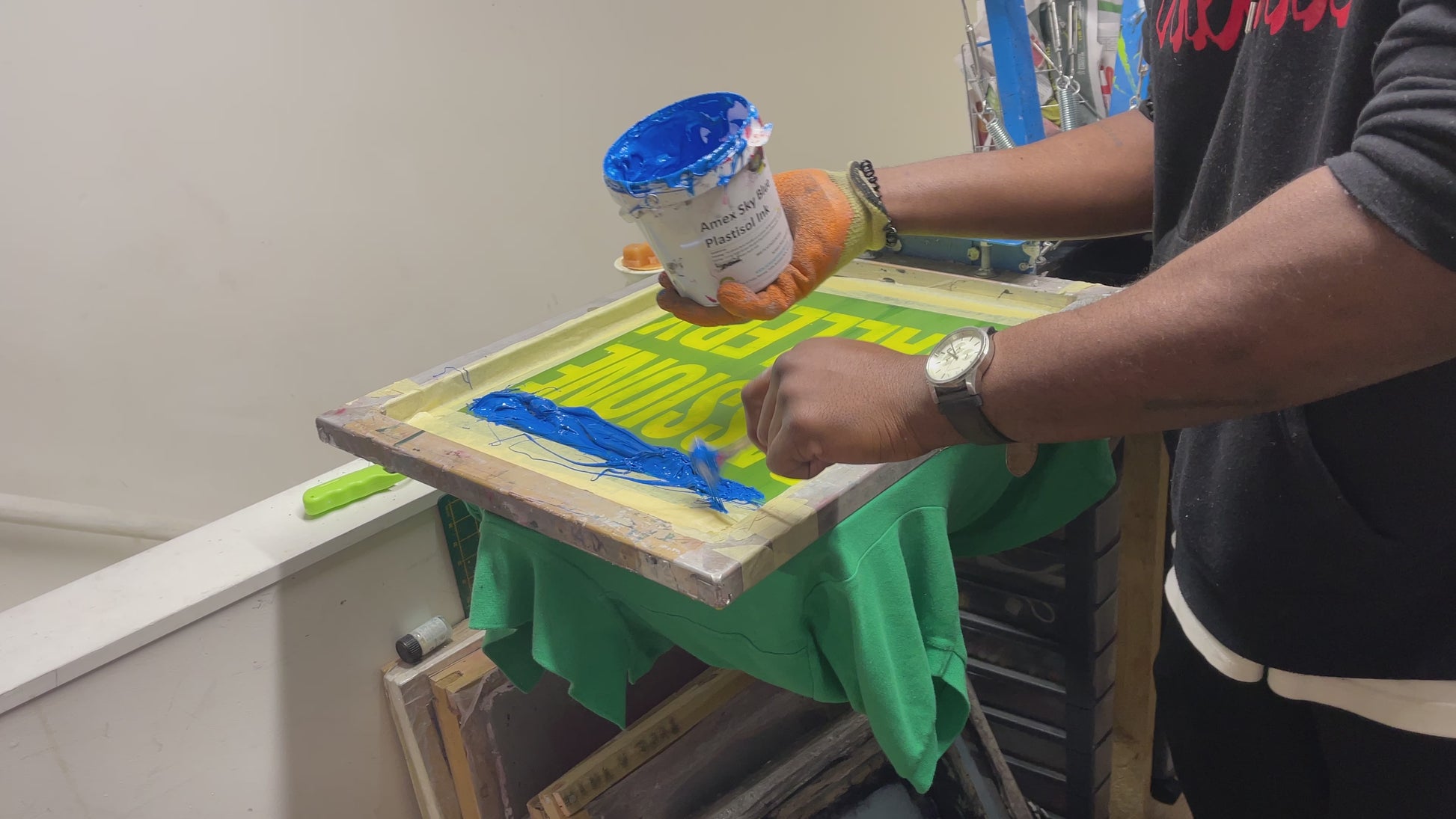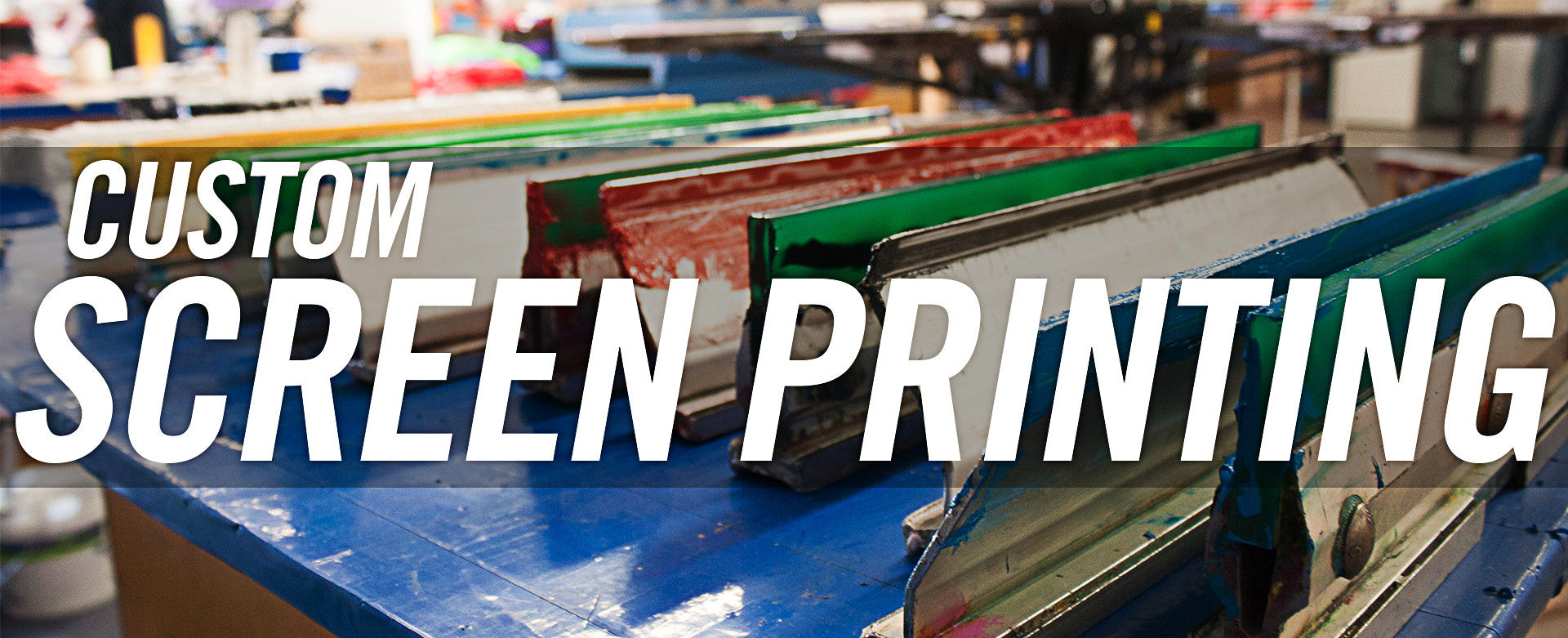Eco-Friendly Custom Screen Printing Options Available
Eco-Friendly Custom Screen Printing Options Available
Blog Article
Display Printing Uncovered: Every Little Thing You Need to Understand About T-Shirt and Garment Printing Methods
Screen printing is an interesting approach that combines art with strategy, using unlimited possibilities for creativity. Ready to discover the essential components that make display printing an art form?
The Essentials of Screen Printing: Exactly How It Functions
When you dive into display printing, you'll discover it's both an art and a scientific research. At its core, display printing involves creating a pattern, or screen, that enables ink to pass with only in particular locations.
Next, you'll blend your inks and prepare your printing surface. Position the display over the textile, then utilize a squeegee to push ink via the screen onto the garment. This process calls for accuracy, as you desire clear, dynamic prints. After printing, you'll heal the ink with heat, guaranteeing it abides by the material and lasts via washes. Each step is vital, and understanding them will raise your display printing skills, changing basic garments right into distinct, expressive pieces.
Sorts Of Display Printing Techniques
As soon as you comprehend the essentials of display printing, it's time to explore the various techniques that can raise your designs. One preferred approach is typical screen printing, where ink is pushed with a stenciled screen. This technique is excellent for vibrant, vibrant colors. Then there's water-based ink printing, which supplies a softer feeling and is environment-friendly, yet it calls for a different method to treating.
If you're going for great information, consider discharge printing. This technique eliminates dye from the textile, leaving a soft, classic appearance. One more choice is plastisol printing, understood for its sturdiness and dazzling shades, making it a preferred for numerous brand names. Experiment with halftone printing to create gradient effects and complex styles. Each method has its special beauty, so do not wait to try them out to find what suits your style best!
Important Equipment for Screen Printing
To attain magnificent results in display printing, having the right devices is essential. You'll need a durable screen printing framework, which holds the mesh that moves your style onto the garment. Next, buy top quality squeegees; these are necessary for using ink uniformly across the display. You'll likewise call for an excellent exposure system to create your screens, as well as a washout booth for cleaning them after use. A reputable heat source, like a conveyor clothes dryer or warm press, is essential for healing your prints to ensure long life. Don't forget a proper work space, equipped with tables and storage space for your products. Safety equipment, such as masks and handwear covers, will keep you secure from chemicals and inks. With the right tools, you'll be well on your method to creating professional-quality prints.
Picking the Right Inks and Products
When choosing inks and materials for display printing, you need to think about the kind of ink that works best for your job. Assume concerning fabric compatibility to ensure your styles look last and great lengthy. Likewise, check out environment-friendly ink options to make your printing process a lot more lasting.
Sorts Of Screen Inks
Selecting the best screen ink is crucial for accomplishing lively, durable prints that meet your task's demands. There are a number of kinds of display inks to take a look at. Specialty inks, such as glow-in-the-dark or metallic, can add unique impacts to your designs.

Material Compatibility Considerations
Understanding fabric compatibility is crucial for attaining top quality screen prints, specifically because various materials respond distinctively to numerous inks. Always examine your inks on example material to guarantee they adhere properly and preserve shade integrity. In addition, keep in mind that material weight and appearance can impact the final result, so picking the best ink and product combination is crucial for your task's success.
Eco-Friendly Ink Options
Eco-friendly inks are ending up being a prominent choice for display printers that desire to reduce their environmental influence while maintaining high quality. When choosing inks, take into consideration water-based inks, which are less unsafe and simpler to tidy up contrasted to traditional solvents. These inks bond well with textiles, delivering dynamic results without hazardous chemicals. You may also explore eco-solvent inks that utilize fewer unstable organic substances (VOCs), making them a more secure alternative for both your wellness and the planet.
Furthermore, search for inks made from eco-friendly sources, such as soy or vegetable-based alternatives. By picking the ideal inks and products, you'll not only create spectacular designs however additionally add to a much more sustainable printing process. Make the switch, and your prints will mirror your dedication to the setting!
Preparing Your Style for Screen Printing

Submit Style Needs
To guarantee your layout looks lively and sharp on textile, you'll require to pay close attention to file style needs for display printing. Begin with vector data like AI or EPS, as they can be scaled without losing high quality. If you make use of raster photos, go with high-resolution files, such as TIFF or PNG, preferably at 300 DPI. Stay clear of using JPEGs, as they can lose quality when resized. Additionally, ensure your style has a transparent history to stop unwanted white edges on your prints. Finally, keep color settings in mind; CMYK is standard for screen printing, so transform your RGB makes accordingly. By following these guidelines, you'll set your art work up for a successful print.
Shade Splitting Up Techniques
Color splitting up is a crucial step in preparing your design for display printing, and grasping it can significantly enhance your print top quality. You'll require to break your layout right into individual shades, as each shade requires a different screen throughout printing. This precision not just ensures exact color depiction but additionally enhances the printing process.
Resolution and Size
Attaining the finest results in display printing starts with ensuring your layout has the best resolution and dimension. Ideally, your art work should go to the very least 300 DPI (dots per inch) for sharp, clear prints. Your last product might look unprofessional and pixelated. if you utilize reduced resolution.
When it comes to size, take into consideration the dimensions of your print area. Style your art work to match the final print dimension, preferably producing it in the real dimensions you'll be publishing. In this manner, you'll avoid any type of unanticipated scaling issues.
Always inspect your layout in both vector and raster layouts. Vector my review here graphics can be scaled without shedding quality, making them suitable for display printing. Preparing correctly will guarantee your design looks impressive on every garment!
Step-by-Step Screen Printing Process
Screen printing is a dynamic process that enables you to create vibrant designs on different surfaces. To start, you'll require a display, solution, and your selected ink. First, prepare your display by cleansing it thoroughly. Next, apply the emulsion evenly and let it dry in a dark area. When dry, subject your screen to light with your design positioned on it, which will harden the emulsion where the light hits, creating a pattern - screen printing kit.
Put ink onto the screen and use a squeegee to press the ink with the stencil onto the material. Raise the screen carefully and allow the print dry. You have actually effectively screen published your style.
Tips for Effective Display Printing Projects
While you're diving into your display printing jobs, keep in mind that prep work is essential to success. Beginning by collecting all your products-- inks, mops, garments, and screens. A tidy work area assists prevent unwanted mistakes, so clean up prior to you start.
Next, validate your artwork is high-resolution and effectively sized for your garment. Check your screen for correct exposure and tidy it thoroughly to prevent spots. When blending your inks, follow the manufacturer's guidelines to accomplish the ideal consistency.
Throughout printing, use even pressure with your squeegee for consistent outcomes. Do not rush; take your time to confirm each print fulfills your criteria. After printing, allow your garments completely dry completely before taking care of or packaging them.
Lastly, constantly maintain a sample of your help future recommendation. This means, you can evaluate your progression and improve your see here now methods gradually. Happy printing!

Regularly Asked Concerns
Just how Lengthy Does It Require To Establish a Screen Printing Job?
Setting up a screen printing task normally takes about 30 minutes to an hour. You'll prepare the screens, mix inks, and readjust journalism. The time varies based upon intricacy and experience, so remain arranged!
Can I Print on Different Textile Keys In Utilizing the Same Method?
Yes, you can print on various textile kinds making use of the same strategy, however you'll need to adjust your settings and inks. Some textiles take in ink in a different way, so exploring guarantees the very best outcomes for each and every material.
What Are Usual Errors to Avoid in Screen Printing?
When display printing, avoid usual errors like using the incorrect ink, overlooking correct direct exposure times, or skipping pre-press checks. Constantly examine your configuration and maintain tidy screens to ensure high quality results each time.
Just How Can I Correctly Tidy and Maintain My Display Printing Equipment?
To properly clean and keep your screen printing tools, you should on a regular basis wash displays with appropriate solvents, inspect mops for wear, and ensure all tools are kept dust-free and dry. Uniformity enhances and stops pricey repair work performance.
Is Screen Printing Environmentally Pleasant Compared to Other Approaches?
Screen printing can be a lot more eco-friendly than various other approaches, particularly if you make use of eco-conscious materials and water-based inks. By selecting lasting materials and techniques, you reduce waste and reduce your effect on the earth.
Screen Printing Uncovered: Everything You Need to Know Regarding Tee Shirt and Garment Printing Strategies
At its core, display printing includes developing a pattern, or display, that allows ink to pass through just in certain locations. Position the display over the fabric, after that utilize a squeegee to press ink with the display onto the garment. One preferred technique is traditional screen printing, where ink is pushed via a stenciled display.When selecting inks and products for display printing, you require to click this link take into account the type of ink that works ideal for your task.
Report this page